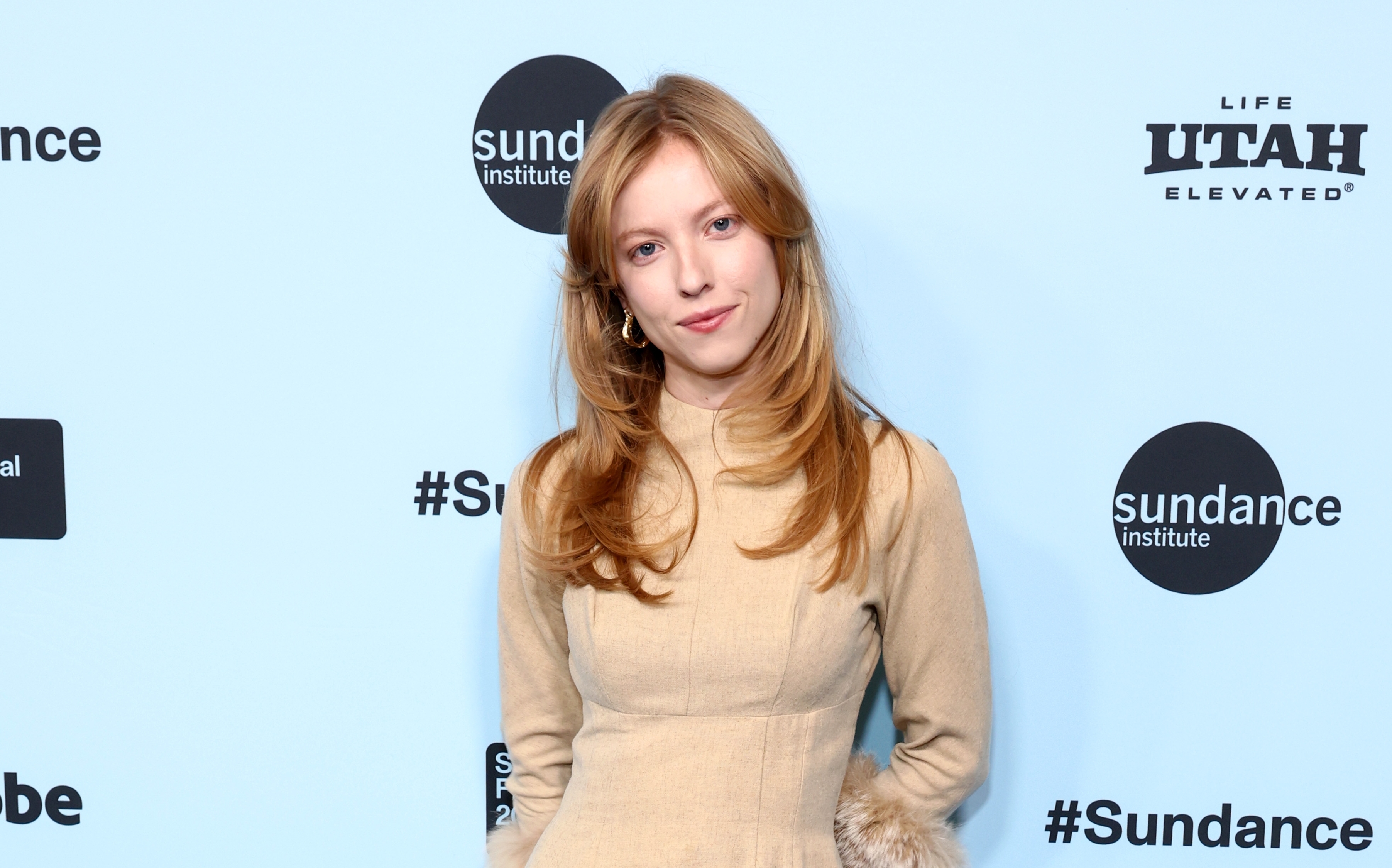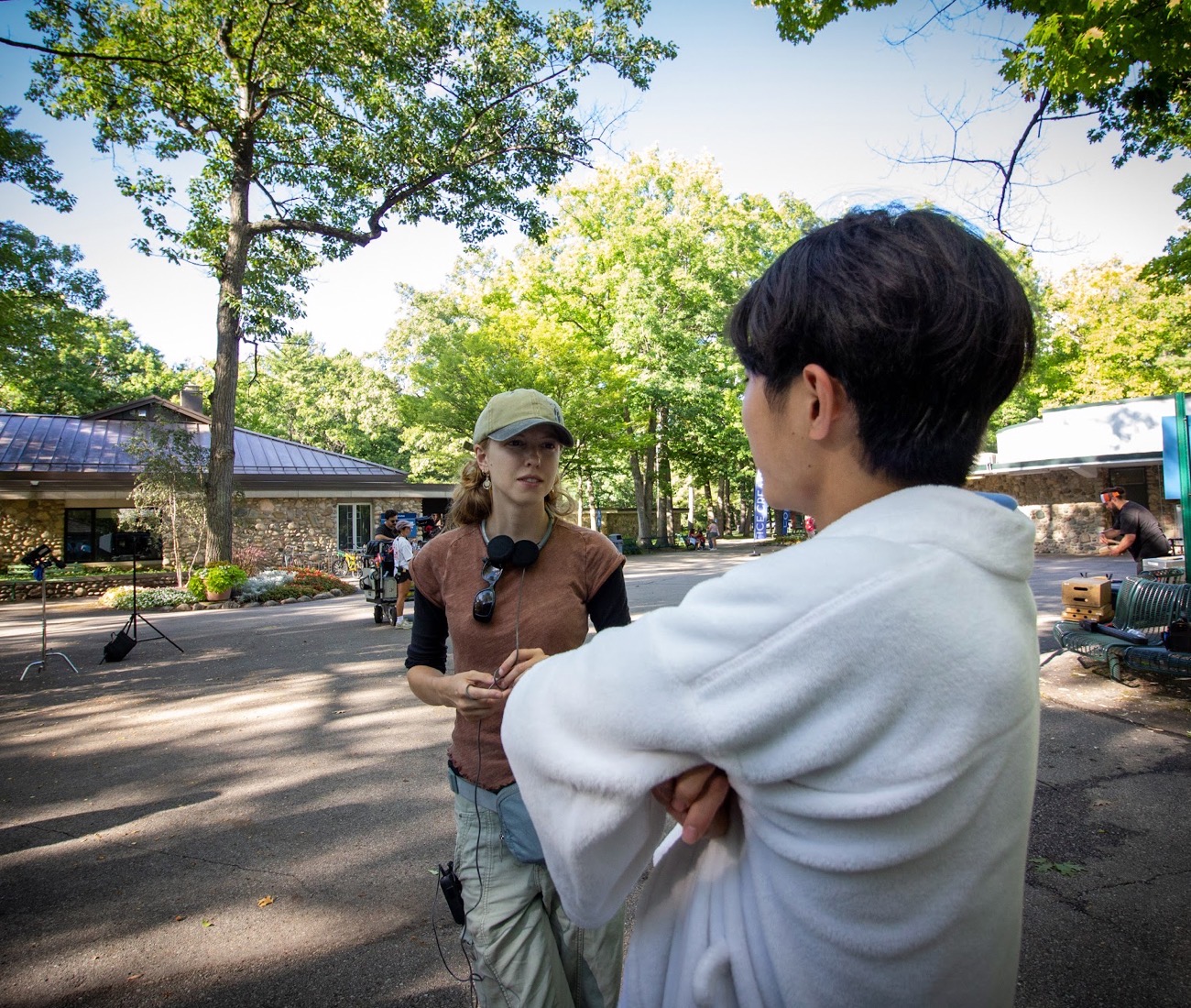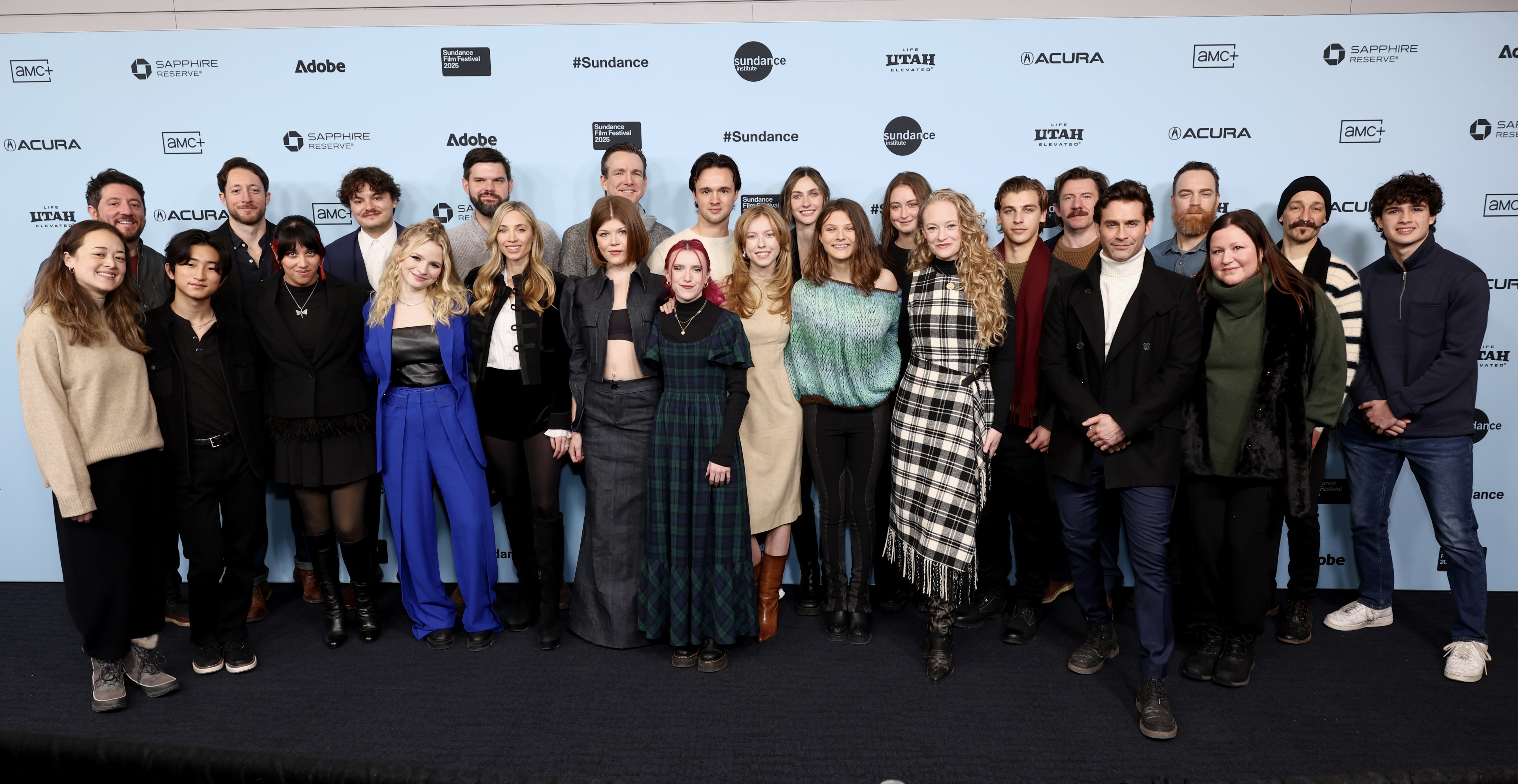TRAVERSE CITY — Traverse City native Sierra Falconer recently made her directorial debut at the Sundance Film Festival with her anthology film “Sunfish (& Other Stories on Green Lake),” which was filmed in Northern Michigan.
The film follows several characters whose lives intertwine around Green Lake as a young girl learns to sail, a boy fights for first chair at Interlochen Arts Camp, two sisters operate a bed-and-breakfast and a fisherman seeking the catch of his life. The film showcases and centers on the picturesque serenity of Green Lake and the impact it has on each of the film’s characters.
The anthology film is inspired by Falconer’s experiences growing up in the Grand Traverse area and served as her master’s thesis at the University of California, Los Angeles.

“I grew up in Traverse City and went to Willow Hill, West Middle School, West High School and then I moved to Connecticut to do my undergrad in film theory at Wesleyan University,” Falconer said. “I graduated in the COVID-19 class of 2020, and then moved to Los Angeles right away to start my master’s at UCLA, and this film was my master’s thesis. They let you do whatever you want for your thesis, and I knew I wanted to come back to Michigan and shoot in Northern Michigan for the film, and that’s how the project was born.”
In concocting the script’s themes, characters and shot concepts, Falconer drew inspiration from her childhood, when she regularly spent time in the summers at her grandparents’ small cottage on Green Lake. She also filmed several of the film’s scenes there.
Falconer said the peaceful and secluded nature of those visits inspired much of the reflective energy the film showcases.

“My grandparents still had their Green Lake that my parents, my sisters and I would go to every summer and hang out there,” Falconer said. “It was a really magical place growing up. There was no cell service and no Wi-Fi there, so we’d always go and we’d have no connection to any of our friends. It felt like we were in the only place in the whole world. It was like a little bubble, it never changed and still hasn’t. We finally got Wi-Fi there for the film, but otherwise, it just feels like this timeless place, and I wanted to capture the feeling of being there and spending a summer there for the film.
“We shot in the cottages that belonged to my grandparents. I was trying to decide what the film was going to be about, and I was struggling to find a single story and a single person that really captured what was most important to me, which was this place and capturing the spirit of it. Ultimately, I decided on the anthology format, which allowed for an exploration of multiple perspectives to see the lake through different people’s eyes, seeing what it means to them at the different points of their lives, which I felt was the best way to capture what it felt like to grow up there at different stages.”
After leaving Northern Michigan for higher education, Falconer found herself longing for the peace that the scenes in Michigan brought her and found that everything she was writing and interested in creatively all came back to reminiscing on memories of time in her hometown.
Falconer called coming back to her hometown to film an exciting and reflective experience.
“A lot of my creative interests are informed by nature, lakes and small-town lifestyle and pace,” Falconer said. “I wanted to come back and capture that and share it. It did feel like I was really coming home, and getting to spend more time in a place was a very cathartic experience in that way, and very personal. My producer of the film is my husband (Grant Ellison), who also grew up in Traverse City, so he also got to come back and be there for it, which was a very cool experience.”
Casting and script
In casting roles for the film, the process was a longer one due to the specific attributes Falconer wanted to bring to each character for the film’s sections to meld together correctly.
She said putting a wider casting call out for the film helped in finding the right fit.

“I knew that there wasn’t a lot of local talent or actors so we cast a really wide net all over the country because I was expecting to fly people in, but we were able to find a few local leads that were very special,” Falconer said. “The second chapter of the film follows a violinist (Jun), and we cast Jim Kaplan who actually was a full-time student at Interlochen at the time. In the final short the younger sister (Blue Jay) is played by Tenley Kellogg, who also grew up in the Traverse City area which was a total coincidence. She submitted her tape, and we loved her. We found out later on that she was from Traverse City and had moved to Los Angeles to be an actress, and very shortly after moving went back to Traverse City to shoot this movie, which was a homecoming for her as well.”
Falconer said having cast members who knew the area well contributed to the true-to-life aspects of Northern Michigan life depicted in the film.
Many background extras cast were also current students at Interlochen Arts Camp or local Grand Traverse County residents.

“I wanted to find characters that authentically captured the place (for) some of the other actors in the third story,” Falconer said. “There’s an actor named Dominic Bogart who plays Finn. Dominic is from the Midwest so he drove up in his car and he has that very Midwestern gruff personality. He’s so perfect for the role. We have all of our extras and the background characters (who) were all locals which was amazing, and the local community was very supportive. The whole summer camp short is all filled out by a bunch of local Traverse City students and teens.”
Three of the four chapter shorts that comprise the film are centered on a coming-of-age film, which Falconer said was purposeful, as she wanted to capture aspects of what she remembers about growing up in Northern Michigan.
Falconer centered the themes around characters learning lessons similar to the ones she learned as a teen in Traverse City.
“I was trying to find different moments that capture a lesson,” Falconer said. “It’s not an autobiographical film, the narratives aren’t what happened to me but I think that the lessons that the characters are learning are true to what I learned in this place. I was trying to find different narratives that ended with this realization or with this moment of change. It’s difficult when you’re writing this type of film because you don’t have as much time with each character. I tried to get into the story at a pivotal moment in the characters’ lives, where it’s an ending and a beginning at the same time they learn something or something changes and then we move on to the next person.
“There are a lot of stories about relationships between mother figures and their children. There’s a sister story, which is really important to me. I have two younger sisters, and that short is about when you’re getting ready to leave and you’re moving on and seeing what happens to the person that stays behind. Another story is about a woman who is in her mid to late 20s who is feeling stuck and looking for excitement. She meets this guy at a bar who is looking for this mythical giant fish, and they go on this adventure together. It’s about feeling stuck, but looking for excitement and trying to find something to believe in.”
Behind the scenes on set
On set, the film’s crew faces two main challenges in bringing Falconer’s script to life including shooting scenes on Green Lake using small boats and capturing the loon scenes using both real and false loon decoys.
Falconer said shooting on the water with expensive camera equipment proved more challenging than the crew anticipated.

“Obviously, we learned very quickly that there’s just the practical challenge of the movement of the water,” Falconer said. “When you point a camera at something on a moving object, it’s moving so it was difficult. Just practically, we were doing a lot of boat-to-boat camera work. In the first vignette, a girl learns how to sail, and we were filming her on a boat sailing and trying to get as close as possible so we could get those close-ups but both boats were moving which made things difficult.”
The crew found the boat used in filming the short centering the fishing expedition on Craigslist for around $500 a few weeks before filming began. The boat didn’t work well, and Falconer said she and the crew were praying that it would float at the very least so they could utilize it.
The old boat did float, but the crew was forced to tow it behind another boat due to it having no working motor.
“The boat would be drifting and we’d have to move the boat back where we wanted it, set up again and shoot the shots,” Falconer said. “Shooting in water is challenging and to get underwater equipment for the cameras is very expensive. We couldn’t afford it, so we were using these splash bags and workarounds that weren’t quite ideal but the water scenes were super important. It was very important to me to be in the water as much as possible with the camera as we could because the characters are in the water so much, and it was really a place of healing for all the characters.

“When we weren’t shooting on the water we were on the land and the water is in the background, and we were shooting on shorter lenses to compress the space between the people and the environment and to really in these wide shots so that it wasn’t always just focused on the people. The background was just as important as the characters.”
The incorporation of the infamous Michigan loon scenes also proved to be tricky for the crew, who worked with a waterfowl specialist who assisted in filming the wild birds safely.
Falconer said including the loons in one of the shorts came largely from her grandparents, who were avid birders.
“A movie I watched at the Green Lake cottage all the time growing up was ‘On Golden Pond,’ which my grandparents loved because of the loons,” Falconer said. “It’s a classic, and I knew we needed the loons. I wrote the loons as a big character in the first story, and I called a national history cinematographer to do a pickup shoot before the rest of the crew came out before the cast was out. We were just shooting the loons and the guy specialized in waterfowl. He shoots for National Geographic and is super, super accomplished. We only had him for three days, and we were just going out on the lake.
“I had plotted the exact days we needed him when the chicks were supposed to hatch because we wanted to get these shots of the chicks on the mama’s back. We got tons of shots of adult looks, but unfortunately, that year was the first year in forever that there were no chicks hatched on the lake and there were no chicks on Duck Lake either right next door. We were going to go over there, but we couldn’t because the hawk population took off this year and they ate all of the chick eggs.”
Due to nature’s path with the chick eggs, Falconer was forced to rewrite the script to make shooting scenes a bit simpler.
“You can’t control animals,” she said. “We did some story reworking and used a lot of tricks to get those scenes to work.”
The Sundance experience
Given that the movie was filmed over one summer, Falconer and her crew couldn’t afford to do reshoots and thus took care to get each necessary scene right visually.
By the time editing began summer had ended and the team was hard at work stitching the scenes together back in Los Angeles. Once editing had been finalized, Falconer was able to hold test screenings with viewers, which she said gave her a lot of positive hope for the film.
“I felt the movie was working, and people were responding well to it but then I was really nervous,” Falconer said. “I had a new fear that no one would ever see the movie, because when you make a low-budget movie it’s really hard to get people to come and see your movie. I think when we got the call from Sundance, that was the moment that I was like ‘People are going to watch it. People like it.’ That was probably the moment that it felt finished.”

Falconer and her team got the call that the film had been selected for the 2025 Sundance Film Festival in November 2024 and they quickly began preparing.
Celebrating with her team after the hard work put into the film was among the biggest highlights of the entire process, according to Falconer.
“When you’re selected you have to keep a top secret,” Falconer said. “You can’t tell anyone except your team. I got the call when I was at work, I had to finish up my shift and then I came home and told my husband first. He was the producer, and we were so excited, we were just jumping around in our house. I was literally jumped so much that night that the next day my legs were sore just from jumping up into excitement.
“That night I made calls to all of our core team and cast and it was the best night ever. I was calling everyone and telling them, because it’s everyone’s dream come true to go to Sundance, and it’s a big team full of mostly people early in their careers and recent grads. It was especially meaningful for all of us, and for a lot of the young talents, it was very meaningful for them as well. It was so just the most exciting night ever.”

At the film festival, Falconer and her team had a handful of screenings each accompanied by a Q&A session afterward which helped give the cast and crew an idea of what audiences took from the film.
Falconer said hearing from viewers and seeing the critics’ reviews roll in helped solidify that she had made an impact with her approaches to the film.
“At Sundance, we had four public screenings and we got to do Q&A with the audiences, which was fun,” Falconer said. “The audience had such good questions. They were really engaged audiences, and I think they responded very well to the film. After the premiere, a lot of the reviews started coming out from critics and that was also really exciting and nerve-wracking to see the critical reception, but it was mostly very, very positive.

“If I had shown people the script and asked for permission, money or support I couldn’t have made this movie in the Hollywood system. It’s not a type of movie that sounds hooky on paper, and it’s kind of a slower movie and a very personal story as an anthology. There were a lot of things that were working against it. We also have no name talent, we had no big producers. We just kept with it because it was what felt right for the project. It’s what we could do with what we had, and that’s what was important to me. In the end, I think I’m very surprised and excited by how positively people are responding.”
In writing and directing the film, Falconer said she learned that if a director makes something very personal, even if it’s not what the market necessarily wants at the moment, people are going to respond.
Doing the press for the movie and interviewing with reporters at Sundance was also a highlight for Falconer and her team, who relished their short time in the spotlight. It was particularly special for Falconer to share the experience with her husband.

“It was so fun,” Falconer said. “It’s really, really rewarding getting to do all of the press and the festivals together as partners and literal partners. There were challenges. The challenge is that we needed to find time to talk about things other than just the movie because compartmentalization is important, but it works well because we just trust each other so much. I think that’s the most important thing between directors and producers. You trust each other, and we already had that foundation built, so it’s easy to move into this together.”
Falconer said she hopes to potentially make another film in Michigan but said due to the state not offering tax incentives for filmmakers it’s a challenge to do. The film is currently up for sale, and Falconer said she is hopeful a distribution company will pick it up as she continues working on other projects.
She is currently in the process of writing another film script and said the success of “Sunfish” gave her a lot of momentum and revitalized energy for the filmmaking process.
“It was so incredible the way the community opened their arms for this film and this project, and I can’t wait for them to see it,” Falconer said. “I did a little screening early on in Traverse City, and it was very well received, but I can’t wait for more people to see it.”